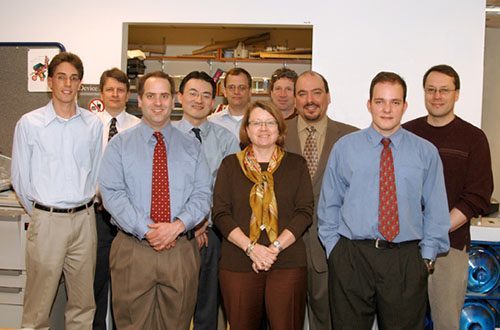Dr. Tempany’s research involves multidisciplinary applications of radiologic imaging, including image-guided therapy, MR-guided focused ultrasound surgery (MRgFUS) interventions, and MR-guided surgical procedures. These techniques are currently being used in patients with breast cancers, uterine fibroids, as well as tumors of the gastrointestinal tract, prostate, brain, bone, and liver. Future technologies will include procedures guided by molecular imaging and gene therapy using positron emission tomography (PET).
Background
A native of Dublin, Ireland, Dr. Tempany graduated from the Royal College of Surgeons in 1981. After completing an internship and residency in internal medicine, Dr. Tempany came to the United States in 1988 to pursue a residency in diagnostic radiology at Loyola University of Chicago. In 1990, she finished a fellowship in magnetic resonance imaging (MRI) at the Johns Hopkins Medical Institutions, Baltimore, MD. She subsequently joined the faculty at Johns Hopkins University as associate director of MRI and was then recruited to Brigham and Women’s Hospital in 1991. Two years later she was appointed Director of Body Magnetic Resonance Imaging in the Department of Radiology. In 1997, she was named Clinical Director of Magnetic Resonance Imaging. Currently, Dr. Tempany is a professor of radiology at Harvard Medical School. At Brigham and Women’s Hospital she has multiple roles. She is Director of Clinical Focused Ultrasound in the Department of Radiology, Clinical Director of the National Center for Image-Guided Therapy (NCIGT) based at Brigham and Women’s Hospital, and Co-director of the Imaging Platform of the Biomedical Research Institute.
Research
Dr. Tempany’s research involves multidisciplinary applications of pelvic MRI imaging, including image-guided therapy, MR-guided focused ultrasound surgery (MRgFUS) interventions, and MR-guided procedures. She co-leads the National center of image guided therapy (NCIGT), and the BWH AMIGO facility with Dr. Ferenc Jolesz. These techniques are currently being used in patients with Prostate and breast cancers, uterine fibroids, as well as tumors of the gastrointestinal tract, prostate, brain, bone, and liver. She is an expert in Prostate cancer MRI and leads a large NIH funded clinical research program in cancer detection, diagnosis (MR guided prostate biopsies), staging and therapy (MR guided radiation therapy and focal therapy for prostate cancer). Future technologies will include procedures guided by molecular imaging and gene therapy using positron emission tomography (PET).
Laboratory

The MRI research section has better than 100 individuals who are working on different aspects of magnetic resonance research. The prostate group, alone, chaired by Dr. Tempany, has 20 team members. Moreover, her efforts are multidisciplinary and include not only radiologists and radiation oncologists, but also surgeons, medical oncologists, computer scientists, physicists, mathematicians, and both software and hardware computer engineers. This large and labor intensive sophisticated effort is at the forefront of cancer research and treatment.
funding
Dr. Tempany’s research is funded through the National Cancer Institute, the National Center for Research Resources, as well as private, corporate, and philanthropic sources.
Collaborations
Dr. Tempany enjoys a great number of collaborations within the Longwood Medical Area and in the New England region, as well as around the country and internationally. In particular, partnering with the Focused Ultrasound Research Laboratory has provided a unique opportunity for conducting dedicated research into the clinical application of this very exciting non-invasive thermal ablation method. In 2005, this group, along with Dr. Elizabeth Stewart from the Department of Obstetrics and Gynecology at Brigham and Women’s Hospital, collaborated on the first FDA-approved MRgFUS device in the US.
Importance of Being at the Brigham
Dr. Tempany believes “the importance of being at the Brigham lies in the multidisciplinary nature of research at the hospital. The Brigham has an outstanding clinical and research faculty and an imaging facility with sophisticated and expensive resources that are not available everywhere. The department administration, specifically, and the hospital administration, generally, have established an infrastructure that is absolutely supportive and essential for cancer research. At the end of the day, people working together as a team is what really makes it all possible.”
Future
- Hegde JV, Mulkern RV, Panych LP, Fennessy FM, Fedorov A, Maier SE, Tempany CM. Multiparametric MRI of prostate cancer: An update on state-of-the-art techniques and their performance in detecting and localizing prostate cancer. J Magn Reson Imaging. 2013 May;37(5):1035-54. doi:10.1002/jmri.23860. PubMed PMID: 23606141.
- Moradi M, Janoos F, Fedorov A, Risholm P, Kapur T, Wolfsberger LD, Nguyen PL, Tempany CM, Wells WM. Two solutions for registration of ultrasound to MRI for image-guided prostate interventions. Conf Proc IEEE Eng Med Biol Soc. 2012;2012:1129-32. doi: 10.1109/EMBC.2012.6346134. PubMed PMID: 23366095; PubMed Central PMCID: PMC3655766.
- Risholm P, Janoos F, Pursley J, Fedorov A, Tempany C, Cormack RA, Wells WM 3rd. Selection of optimal hyper-parameters for estimation of uncertainty in MRI-TRUS registration of the prostate. Med Image Comput Comput Assist Interv. 2012;15(Pt 3):107-14. PubMed PMID: 23286120.
Selected References
1. Cedeno-Laurent F, Opperman MJ, Barthel SR, Hays D, Schatton T, Zhan Q, He X, Matta KL, Supko JG, Frank MH, Murphy GF, Dimitroff CJ. Metabolic inhibition of galectin-1-binding carbohydrates accentuates anti-tumor immunity. J. Investigative Dermatology, 2012; 132(2):410-420.
2. Cedeno-Laurent F, Opperman MJ, Barthel SR, Kuchroo VK, Dimitroff CJ. Galectin-1 triggers an immunoregulatory signature defined by IL-10 expression. J. Immunology, 2012; 188(7):3127-37.
3. Cedeno-Laurent F, Watanabe R, Teague JE, Kupper TS, Clark RA, Dimitroff CJ. Galectin-1 inhibits the viability, proliferation and Th1 cytokine production of non-malignant T cells in patients with leukemic cutaneous T cell lymphoma. BLOOD, 2012; 119(15):3534-8.
4. Dimitroff CJ. Leveraging fluorinated glucosamine action to boost anti-tumor immunity. Current Opinion in Immunology, 2013, 25(2):206-13.

